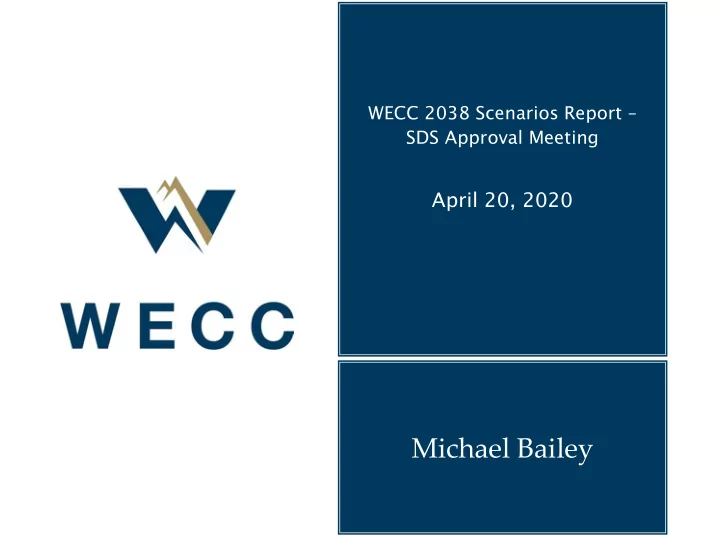

WECC 2038 Scenarios Report – SDS Approval Meeting April 20, 2020 Michael Bailey
Meeting Plan Presentation on Report Highlights Remarks by the WECC Scenarios Task Force Questions, Answers, and General Discussion Approval Vote 2
Scenario Development Workshop WECC and its stakeholders developed the four future scenarios for the Western Interconnection based on a “focus question” developed during a scenario development workshop held March 27-28, 2018 at WECC’s headquarters in Salt Lake City, Utah. 3
Focus Question How might customer demand How do we define customers, in what segments or categories? With DER? Grid connected? for electric services What services beyond commodity supply of electricity? What kinds of enhanced services? in the Western Interconnection evolve as new Technology innovation that affects distributed technologies energy as well as utility scale supply and delivery systems. and policies Policies at all levels. create more market options, and with that, Markets: regulated and unregulated. Options: Power supplies. what risks and opportunities may emerge for Who and what players will be in it? the power industry in sustaining electric reliability? What risks to the reliability of the BPS in the Western Interconnection? What standards and requirements apply? 4
Scenario Matrix 5
Study Tools GridView tool used for production cost model (PCM) analysis. WECC Generation Capital Cost Tool for capital expansion analysis. PowerWorld tool used for power flow analysis and the construction of the PCM model and to perform data validations. Various productivity tools to create model inputs, parse results, and create charts and tables. The NREL Electrification Futures Study ( EFS ), Demand-Side Scenarios, and Standard Scenarios. 6
Generation Resource Model NREL Mid-Case Resource Model 7
Generation Resource Additions Candidate Generation Portfolio Capacity Additions: 2038 vs 2028 (121 GW) Utility PV Storage Rooftop PV Oil-Gas-Steam Offshore Wind Nuclear NG-CT NG-CC Land-based Wind Imports Hydro Geothermal Curtailment CSP Coal Biopower 0 5,000 10,000 15,000 20,000 25,000 30,000 35,000 40,000 MW 8
Generation Resource Comparison – 2038 vs 2028 9
Resource Mix – Reference Case 10
Resource Additions/Displacements – Reference Case 11
Reduction in CO 2 Emissions 12
Reduction in Water Consumption 13
NREL Demand-Side Load Profiles 14
NREL Demand-Side Load Comparison 15
Annual Load Comparison 16
Load CAGRs 17
Diurnal Load Shapes – Reference Case 18
Diurnal Load Shapes – Scenario 1 19
Diurnal Load Shapes – Scenario 2 20
Net Load – Reference Case 21
Net Load – Scenario 1 22
Net Load – Scenario 2 23
Unserved Load – Reference Case 24
Unserved Load – Scenario 1 25
Unserved Load – Scenario 2 26
Storage – Reference Case 27
Storage – Scenario 1 28
Storage – Scenario 2 29
Path Utilization – Reference Case 30
Path Utilization – Scenario 1 31
Path Utilization – Scenario 2 32
Path Utilization – Seasonal Variations 33
LCOE – New Generation 34
LCOE – Existing Generation 35
Capital Expansion Costs 36
Key Takeaways – Load Growth 1.76% Weighted Average CAGR for Western Interconnection based on IRPs. NREL EFS bottoms-up approach to load modeling suggests most electrification load growth will come from Electric Vehicles. Electrification, in this study, focused on fuel- switching transition. 37
Key Takeaways – Unserved Load Main Contributors to Occurrences of Unserved Load: • Diurnal Electrification Demand Higher at Evening Peak • Displaced Baseload Resources (Coal) • Higher Penetrations of Variable Resources (Especially Solar). Storage and Dispatchable Demand-Side Options Highly Effective at Reducing Unserved Load. 38
Key Takeaways – Resource Mix Increased dependence on gas, solar, and wind for resource adequacy. Coal displaced. Increased dependence on gas for flexibility. Solar, without storage partner, contributes little to ELCC at evening peak. Gas was marginal in commitment at peak. Storage and demand-side management highly effective to mitigate against unserved load by flattening the diurnal load shapes. 39
Key Takeaways – DER DER expected to double by 2038. Growth in DER expected to come primarily from solar PV. Electric vehicles (EV) are the wild card in DER growth, depending on deployment and implementation strategies. Time-of-use strategies for EV could be of great benefit or detriment. 40
Key Takeaways – Inter-Regional California largest importer (yesterday, today, tomorrow). Rocky Mountain region becomes net importer with coal retirements. Exports from the Desert Southwest and Basin regions increase with increases solar and coal retirements. Path transfers from Desert Southwest and through Basin increase. Energy production from Desert Southwest especially important during Winter months. 41
Key Takeaways – Economics Close correlation between LMP price spikes and unserved load capped at $4000/MWh modeled in GridView. LMPs range from high positive (unserved load) to negative (energy spillage). Energy spillage driven by higher levels of solar at lower load levels. LCOEs for new resources within the average PCM commitment/dispatch window between $100/MWh and $25/MWh. Life extension are estimated to be roughly 60% of new builds. 42
Key Takeaways – Environmental CO2 emissions in 2038 decreased by roughly 30% from that of 2018, from 0.27 billion metric tons to 0.19 billion metric tons, primarily due to the displacement of coal. Water consumption for thermal cooling in 2038 decreased by roughly 19% from that of 2018, from 190 billion gallons to 154 billion gallons, primarily due to the displacement of coal. 43
Forward Looking – Sensitivity Studies Demand-Side Management Fuel Prices Resource Flexibility Electrical Storage ADS Extension to 20 year time-frame Load and Generation Ensembles Micro-Grids EV Deployment Strategies Distributed Energy Resources Consumer Choice Modeling Simultaneous Feasibility Modeling 44
Contact: Michael Bailey, P.E. Senior Staff Engineer mbailey@wecc.org 45
Recommend
More recommend